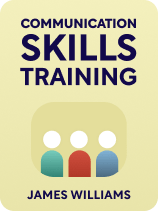
Do you go into conversations with confidence? How often do people misunderstand you? When is it appropriate to ask someone specific personal questions?
Communication Skills Training, a book by James Williams, explains that good communication skills don’t come naturally. Instead, they’re built up over time through intentional practice. Williams lays out the skills you need for interpersonal communication and provides a few tips on public speaking.
Continue reading for an overview of this practical book that can help you hear and be heard more effectively.
Overview of the Book Communication Skills Training
Communicating effectively with others is a crucial skill—it’s how we build and maintain relationships, solve problems, and accomplish tasks. Communication Skills Training, a book by James Williams, outlines the core abilities of effective communication and how to develop them so you can communicate well, build your charisma, and win people over.
Williams is a bestselling author who focuses on self-improvement topics like building confidence, improving communication skills, and developing emotional intelligence. After struggling with shyness and social anxiety, he sought out psychological techniques that would help him boost his confidence and ability to connect with others. This journey inspired him to become an author and share his discoveries with others. His advice is based on a combination of personal experience and research. His other books include Emotional Intelligence, How to Talk to Anyone About Anything, and How to Make People Like You.
We’ve broken Williams’s advice down into two main sections. In Part 1, we’ll explore four core abilities of effective communication—active listening, establishing connections, controlling emotions, and being accurate and clear. We’ll outline why they’re important and how to develop them. In Part 2, we’ll discuss how to communicate effectively in three scenarios—handling misunderstandings, navigating feedback discussions, and giving public presentations.
Part 1: The Core Abilities of Effective Communication
Williams identifies active listening, establishing connection, emotional control, and accuracy and clarity as core communication abilities. Let’s take a look at each.
Ability #1: Active Listening
Williams explains that to communicate effectively, you must fully understand the other person—not just the content of their statement, but the emotions and intent behind it. To form this understanding, you must actively listen. Pay attention not just to what they say, but how they say it—their tone, word choice, body language, and so on. If you don’t, you may misunderstand the other person—or miss their main point—and therefore respond inappropriately.
For example, your friend might be telling you about their son’s soccer game and an encounter they had with a mean person there. Their eyebrows knit and their tone sounds dejected—their intent was to express their hurt feelings from the encounter. However, you respond by asking who won the soccer game because you weren’t paying attention to the smaller details that indicated which part of the person’s story was most important.
Williams provides four main tips for practicing active listening.
Tip #1: Prepare to Receive the Other Person’s Message
To prepare to receive the other person’s message, Williams makes three main recommendations. First, make eye contact. Second, fully concentrate on the other person. Third, keep an open mind so you can receive their message without making judgments.
Tip #2: Receive Their Message
To effectively receive someone’s message, Williams says you must continue to focus entirely on the other person. Listen to what they say and don’t say, and try to pick up on their emotions by paying attention to their tone, facial expressions, body movements, and so on. Avoid thinking about your response to their message or making judgments on what they’ve said—you can’t listen and reflect at the same time. Further, show the other person you’re listening by nodding along or giving vocal affirmations like “mhm.”
Tip #3: Prepare to Respond
Williams says to make sure the other person is completely finished speaking before you formulate your response. Plan to match your emotions to theirs—this will help you respond appropriately. For instance, if they seem sad and muted, avoid being inappropriately exuberant and joyful. Further, make sure you respond to the main point they’re making rather than the unimportant details.
Tip #4: Respond Effectively
When you respond, Williams recommends showing the other person you understand them by sharing your interpretation of what they said, explained in your own words. Further, avoid responses that might indicate you’re uninterested in listening to them or want to make things about yourself—for instance, offering advice, pity, corrections, comfort, or personal stories, or trying to one-up them.
Ability #2: Establishing Connection
Next, Williams explains that effective communicators must establish connections with others. This is because as factors in your life change, such as your job or where you live, you’ll be forced to meet new people and build new relationships.
Williams offers four main tips for building new connections:
Tip #1: Mind Your Confidence
Williams explains that it’s important to enter conversations with confidence and high self-esteem. When you’re confident, other people will see you as credible, which leads to a more effective conversation. Williams notes you can express confidence through your non-verbal communication—your tone, body language, expressions, and so on. Specifically, sit up straight with your shoulders back and your chin high. Further, monitor your tone—being too quiet can make you seem timid.
Tip# 2: Be Authentic
Despite monitoring your words, tone, and body language, Williams warns not to censor yourself too much. Be your authentic self—people are attracted to authenticity. For example, if you’re a jokester, use humor, and if you’re into more philosophical topics, discuss them.
Tip #3: Find Common Ground
Williams explains that finding common ground—shared interests, dislikes, experiences, and so on—is one of the best ways to establish a connection with someone. It’ll also help you further your connection by giving you natural conversation topics.
However, Williams warns against asking the other person specific personal questions too soon—this can make people defensive, especially when you’re first getting to know them. Instead, be more general: Ask them to tell you more about themselves so they can offer up whatever information they feel comfortable disclosing.
Tip #4: Pay Attention to Personality
Williams recommends figuring out the person’s personality type and tailoring your communication to match their type’s preferred communication style. For instance, if your conversation partner is impatient and focused on getting to the point, be direct with them and avoid mentioning any unnecessary details that they may see as a waste of time.
Ability #3: Emotional Control
Williams explains that emotional control is central to effective communication because, when we’re unable to control strong emotions, we tend to express ourselves poorly—for example, by yelling, making accusations, or failing to clearly explain our message. When we express ourselves in such ways, the other person will likely struggle to understand us, and they may even become offended and shut us out.
Here are four tips for controlling your own strong emotions and avoiding triggering them in others:
Tip #1: Manage Your Emotional Triggers
Williams advises learning what types of situations and pet peeves trigger your strong emotions. That way, you can prepare for these situations in advance and catch yourself before you react emotionally. For example, when you anticipate a trigger, close your eyes and imagine petting your dog to calm yourself down.
Tip #2: Overcome Negative Assumptions
Often, we react emotionally due to negative assumptions we make about others and their intentions. For example, if someone’s tone seems demeaning to you, you might get angry and accuse them of patronizing you. To avoid this, Williams recommends replacing negative assumptions with positive ones. For instance, instead of patronizing you, maybe this person is trying to be gentle so they don’t hurt your feelings.
If you can’t convince yourself of positive intent, avoid resentment by simply accepting that everyone is different and has their own flaws and characteristics—you can’t control people, so accept them for who they are.
Tip #3: Write Out Your Thoughts
When you feel strong emotions like anger or stress, Williams says to write down your thoughts and feelings to release them. This will also help you determine how rational your emotional reactions are—writing helps you organize your thoughts so you can make a more accurate judgment on whether or not your feelings are reasonable.
Tip #4: Be Respectful
When talking about your emotions, Williams recommends using “I feel” statements to express yourself—for example, “I feel hurt about what happened” or “I feel anxious about this situation.” This will help you avoid making unfair accusations, even when you’re angry or believe the other person’s at fault because you’re focusing on describing your emotions rather than the other person’s actions.
Further, focus on the issue at hand—don’t bring up unrelated past issues that you’re harboring negative emotions about. This could upset the other person and ignite negative emotions for you as well.
Ability #4: Accuracy and Clarity
Williams explains that expressing yourself accurately and clearly is crucial. If you don’t, the other person will likely misunderstand you, and you’ll fail to achieve your goal for the conversation. He offers the following tips for staying accurate and clear:
Tip #1: Communicate About Important Topics Face-to-Face
Williams suggests holding important conversations face-to-face, not via text messaging, noting that misunderstandings are much more common in written communication like texts or emails. This is because you’re not able to pick up on nonverbal elements like tone, body language, and facial expressions, which are important to understanding the other person’s feelings and intent.
Tip #2: Be Concise and Direct
Williams recommends using as few words as possible whenever you communicate—the fewer words you use, the less room there is for misinterpretation. Further, directly state what you want or need to make it easier for the other person to understand your message.
Tip #3: Check For Understanding
Rather than assuming you and the other person understand each other, Williams says you must regularly check in by summarizing what’s happened in the discussion so far and ensuring the other person is on the same page.
Part 2: Crucial Scenarios of Effective Communication
Let’s discuss how to handle three common scenarios that will put your communication skills to the test.
Scenario #1: Managing Misunderstandings
While being clear and accurate in your communication reduces the chances for misunderstandings, Williams explains that they still might happen. As such, it’s crucial to understand how to manage them so you can get the conversation back on track. Williams offers a few tips to salvage the conversation when misunderstandings occur.
Tip #1: Pause and Identify the Issue
When you realize a misunderstanding occurred, Williams says to pause the conversation and address it immediately. Take a moment to figure out what exactly was said or done to cause the issue so you know what to address.
Tip #2: Be Mindful
When someone gets offended, Williams says you must be mindful of your emotions and keep your cool. Fully consider their perspective on what you might have done wrong—this will help you see how you might need to change your behavior. Then, take accountability for any mistakes or contributions you made to the issue or misunderstanding.
Tip #3: Don’t Involve Outside Parties
Williams explains that involving third parties in a misunderstanding complicates the issue and makes further miscommunications more likely. Outsiders are unlikely to have a complete and accurate perspective and background on the situation being discussed.
Scenario #2: Feedback Discussions
Williams explains that feedback is an important and unavoidable part of everyday communication, making successfully giving and receiving it crucial. However, we often struggle to accept feedback and criticism because it impacts our self-esteem, and our brains reject it to protect us. Therefore, to improve ourselves and help others do the same, we must learn how to give feedback to others without triggering their or our defenses.
Here are some tips for both giving and receiving feedback effectively.
Tip #1: Give Feedback With Positive Intentions
Before giving feedback, Williams advises making sure you’re doing it to help the other person improve in some way—don’t give it just to make them feel bad or simply criticize them.
Tip #2: Soften Critical Feedback With Praise
Williams suggests softening critical feedback with positive feedback: Start your statement with a compliment, then give your criticism, and then give another compliment to end on a positive note. This technique highlights the other person’s strengths so they’re less likely to focus solely on the criticism and become offended or discouraged. For example, you could say, “The painting you made yesterday was really beautiful, I love how colorful it was. However, I noticed that you left a little mess on the table afterward. Next time, I’d really appreciate it if you could clean up after you finish. I absolutely love that painting though, it brightens up the whole room!” This way, the other person will get your message while feeling uplifted at the same time.
Tip #3: Seek Out Feedback to Get Used to Receiving It
Williams argues that the only way you’ll get good at receiving feedback is through regular exposure to it. As such, you should ask for feedback as often as possible.
Tip #4: After Receiving Feedback, Reflect On and Accept It
Once the other person finishes giving you feedback, Williams recommends taking a moment to fully process what they’ve said before responding. Consider how true their feedback is so you can decide if and how to implement it, and explain how you plan to do so in your response.
Scenario #3: Public Presentations
Williams argues that being able to effectively deliver public speeches or presentations is a crucial skill because it can expand your career options and professional network and help you share your ideas.
Here are four tips to help you prepare for and execute an effective presentation.
Tip #1: Choose a Relevant, Helpful Topic
To engage your audience, Williams says you must understand them so you can select a topic that they’re interested in. The best way to interest them is by providing them with something they need—solutions, advice, or information. For example, imagine that you’re a guest speaker at a library event for kids who are bored at home for the summer. They probably want to learn about something fun they can do to pass the time. The topic of your speech can be about how to build a model volcano at home—something that will solve their problem of boredom.
Tip #2: Write Your Speech
Williams says that the first step of writing your speech is researching all angles of your topic so you’re knowledgeable and can answer any questions you’re asked.
Once you have this background knowledge, it’s time to write your speech. One possible speech structure is to start by catching the audience’s attention by introducing a problem they have that you can solve. Then, explain why they’re struggling to solve that problem and provide your solution. Next, provide facts supporting your solution, explain why it works, and show the audience how it’ll solve the problem. Conclude by calling your audience to take action.
Tip #3: Prepare for Your Presentation
Williams recommends practicing reciting your speech mostly from memory in the days before your performance—you don’t want to read your entire speech from a sheet of paper during your presentation. Instead, create notecards with refreshers of your main points that can help spark your memory during your speech.
Tip #4: Execute Your Speech
Williams says you must stand up straight and exude confidence while presenting—this will make people more inclined to listen to you. Further, be enthusiastic to get your audience excited, and speak to them in a conversational manner. If you come off as overly professional, the audience may struggle to relate to you and lose interest in your message.

———End of Preview———
Like what you just read? Read the rest of the world's best book summary and analysis of James Williams's "Communication Skills Training" at Shortform.
Here's what you'll find in our full Communication Skills Training summary:
- Why effective communication is one of the most important skills to have
- How to develop your communication skills through intentional practice
- Why emotional control is central to expressing yourself effectively






